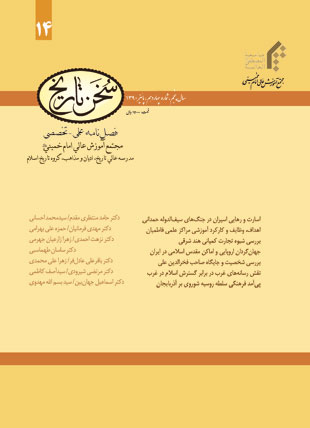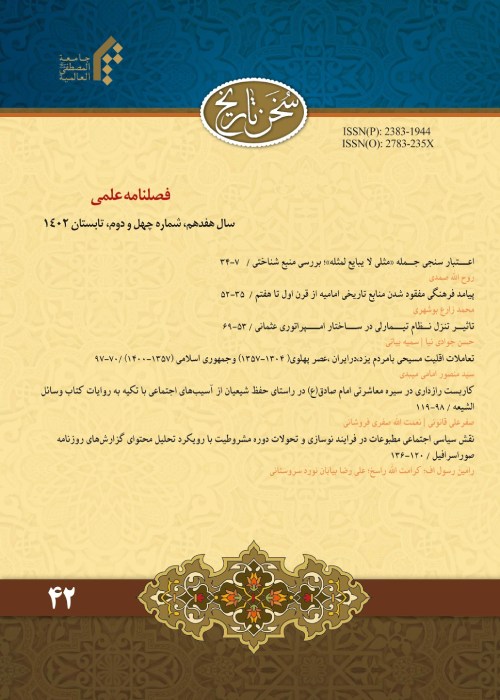فهرست مطالب

نشریه سخن تاریخ
پیاپی 14 (پاییز 1390)
- بهای روی جلد: 15,000ريال
- تاریخ انتشار: 1391/01/29
- تعداد عناوین: 7
-
Page 3
Different religions, sects and nations have highly considered manners toward the captives. As Hamdanid were ruling in borderlands, they were involved with numerous wars against Muslim governments’ adversaries. Sayf al-Dawla, Ali ibn Abd Allah ibn Hamdan, the ruler of Halab (Aleppo) in first half of fourth century A.H, had many military struggles with Byzantines. Consequently, many soldiers and inhabitants were captured during such battles. In addition to soldiers, commanders and inhabitant, some renowned and famous figures were captured by both Hamdanid and Byzantines in wars. he Hamdanid was known as a Shiite government, on the other hand, religious motives and dignity led Christian Byzantine government to fight against Muslims to get their holy lands back. Therefore, both governments fought with religious motivations. This paper will be a descriptive and analytic study on the identity of captives, destiny and manners toward them in both Hamdanid and Byzantine government.
-
Page 29Da’wah Organization, for preaching and announcing Islam, was one of the most important factors in expansion and achievements of Isma’ilis, which led to the establishment of Fatimid dynasty, one of the largest Islamic Empire in 4th century A.H in Morocco and Egypt. The main functions of Da’wah organization were: efforts to establish Fatimid government in Egypt, efforts to expand Isma’ilism all around the world – in India and Sind, and political, social and economic functions. Educational spaces are one of the most important bases in educational institution. Through studying of educational spaces in Da’wah organization, their goals, duties and function as an educational institution in Fatimid dynasty will be discussed. Libraries, Dar al-‘ilm (houses of knowledge), Dar al- Hikma, mosques and palaces were the most important educational centers in Da’wah organization that will be analyzed in this paper.
-
Page 55Safavid Islamic dynasty is one of the most important eras in history of Iran. For some reasons they enjoyed an excellent situation; development of international commercial relations and trades with European east India companies is one the main reasons. In this era (11th century A.H or 17th A.D) Persian Gulf played an important role in commercial trades between Iran and European countries. Also powerful European countries like England, Netherland and France had trade offices in Persian Gulf harbors, in order to monopolize trades in the East. The main problem of those companies was shortage of liquidity or money for foreign investment. As they were eagerly interested in business with east India companies, they had to find a solution for their problem. Also their representatives managed their business according to the needs of European market and their own demands. Therefore, they intended to conduct their business in spices, textile, metal ware, medicine and food with east India companies. Therefore, they competitively used regular shipping lanes between Iran and Indian harbors for transportation of passengers and Iranian and Indian merchant’s goods. The main question of this paper is: What are the effects of east India companies’ business methods in Persian Gulf in Safavid era? Also the hypothesis declared here is: east India companies’ business methods had clear impact on developing and thriving trade harbors in Persian Gulf in Safavid era.
-
Page 89Iranian reaction to European tourists, who visit holy sites in Iran, can clearly demonstrate Iranian attitude to West and western culture. Considering the importance of this issue, this paper will study Iranian reaction to European tourists from Timurid dynasty to Pahlavi era. At first based on Clavijo’s travel account, Timurid dynasty will be analyzed. Then, Safavid dynasty will be analyzed, in this era the relations between Iran and Europe reached its climax, as a result numerous travel accounts are available on this subject. After that, short period of Zand and Afsharid dynasties will be discussed. The large part of this paper is dedicated to Qajar dynasty, which is divided into four parts: 1. Muhammad Khan Qajar and Fat’h-Ali Shah Qajar; 2. Muhammad Shah Qajar; 3. Naser al-Din Shah Qajar to Enqelab e Mashruteh (Constitutional Revolution); 4. From Constitutional Revolution to Pahlavi era. Research methods in this paper are historical method, library resourcesand also notes from European travel accounts. Based on these travel accounts some hypotheses are presented here: Before Qajar dynasty and even in some periods in Qajar era Iranian people had positive attitude to Europeans and they were easily allowed in holy sites; but following the escalation of conflicts between them, Iranian people could not stand Europeans in holy sites.
-
Page 111Sahib Fakhr al-Din Ali was one of the political figures of Sultanate of Rum after the occupation of Anatolia by Mongols. He was counted as an Iranian politician in Anatolia who cooperated with Mongols against Turkamans who were always seeking power. He held a number of high offices in government. Fakhr al-Din and Mu’in al-Din Pervane, a high rank politician in Sultanate of Rum, were contemporaries, and their attitude toward each other was depended on its situation. Following betrayal of Pervane in Obolestan war, in 676 A.H, Abaqa take him down and he was found guilty in court of law. Although Fakhr al-Din Ali helped Mu’in al-Din in this anti-Mongol action but he stayed away from punishment. Some years later with supporting of Mongols he became a vizier. In this paper, stability of his position, as a vizier, his personality, and position and his political activities, which are unknown through history, will be discussed.
-
Page 137Today is the era of communication, and our social, political and cultural life is hugely affected by mass media. In this era, the power of mass media is a key to evaluate the quality of public opinion in each society. Mass media can play an important role in emergence of new custom, evolution of global culture and change in human behavior and manners. On the other hand, researchers and intellectuals always consider the relationship between Islam and the West. After September 11 attacks and Crusades analysts are highly focused on this relationship. Considering the growing spread of Islam and increase of Muslims population in the West, some western politician raised the issue ofIslamophobia. Today this issue is introduced as the main social crisis of western citizens, which is almost tangible in the western media. In this paper Islamophobia will be defined and the role of western media as the most important software tool in this subject will be discussed.
-
Page 181Domination of every country or government over another land would have consequences in many aspects, such as political, economic, social, religious and more importantly cultural effects. Domination of Russia over independent countries had special effects on them though decades. Russian government believed in opposing religious matters, and they treated people strictly. In this paper after studying the cultural background of Azerbaijan, the political domination of Soviet Union over this country will be discussed. Then the cultural consequences will be evaluated in two positive and negative parts. The negative consequences appeared mainly in religious culture. Elimination of clergymen and religious intellectuals, elimination or change in utilization of religious centers, brutal religious suppression and opposition with religious teachings, change in script and language and promoting Marxism were the negative results. On the other hand, the positive consequences emerged in education, doing research, expansion of educational and research institutions and launching visual and auditory media.


